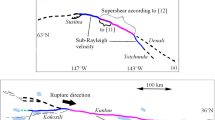Abstract
— Our current conceptions of earthquake rupture dynamics, especially for large earthquakes, require knowledge of the geometry of the faults involved in the rupture, the material properties of the rocks surrounding the faults, the initial state of stress on the faults, and a constitutive formulation that determines when the faults can slip. In numerical simulations each of these factors appears to play a significant role in rupture propagation, at the kilometer length scale. Observational evidence of the earth indicates that at least the first three of the elements, geometry, material, and stress, can vary over many scale dimensions. Future research on earthquake rupture dynamics needs to consider at which length scales these features are significant in affecting rupture propagation.
Similar content being viewed by others
Author information
Authors and Affiliations
Corresponding author
Additional information
Acknowledgements Thanks to Joe Andrews and Steve Day, Peter Mora, and two anonymous reviewers for constructive comments that improved the manuscript.
Rights and permissions
About this article
Cite this article
Harris, R. Numerical Simulations of Large Earthquakes: Dynamic Rupture Propagation on Heterogeneous Faults. Pure appl. geophys. 161, 2171–2181 (2004). https://doi.org/10.1007/s00024-004-2556-8
Received:
Issue Date:
DOI: https://doi.org/10.1007/s00024-004-2556-8




